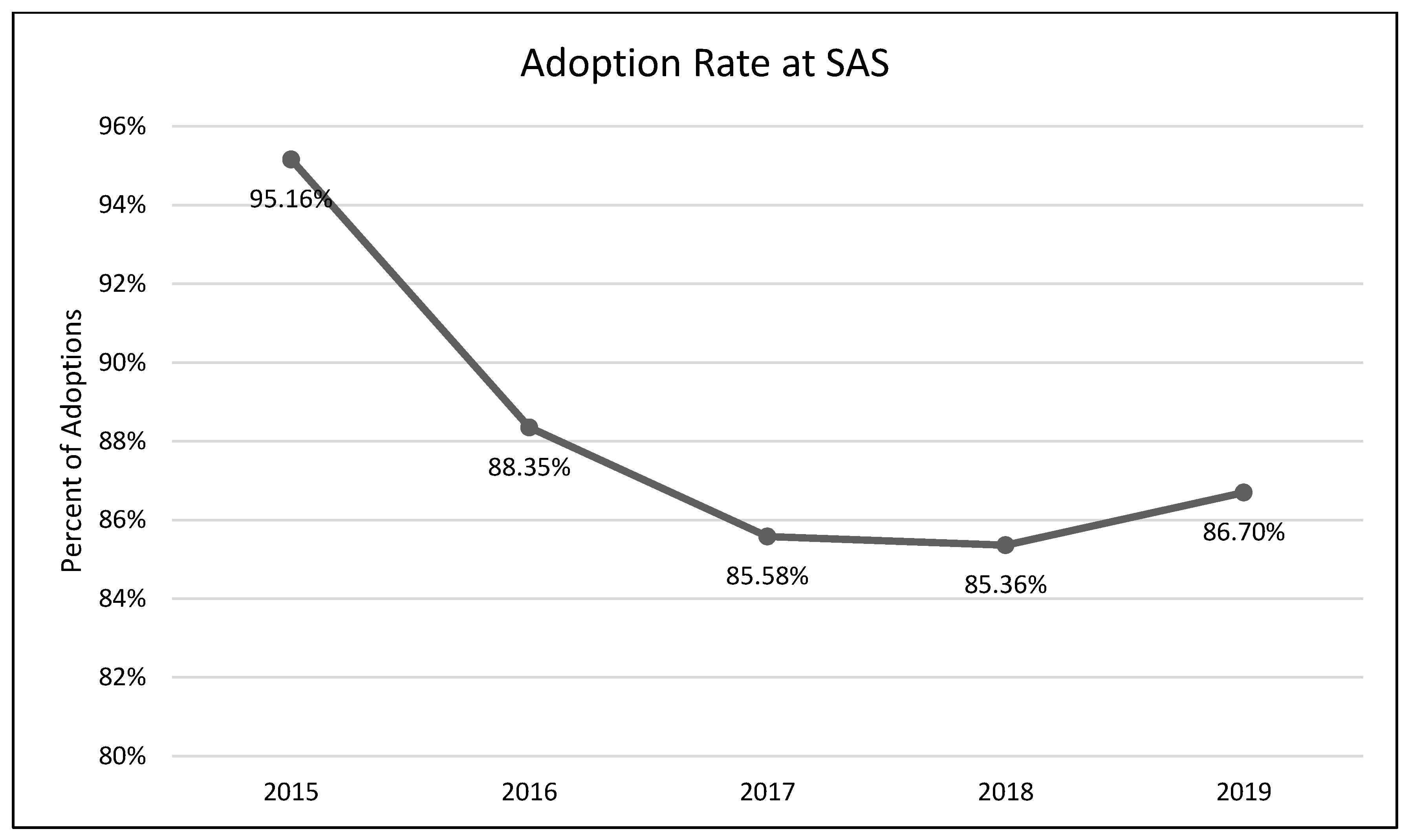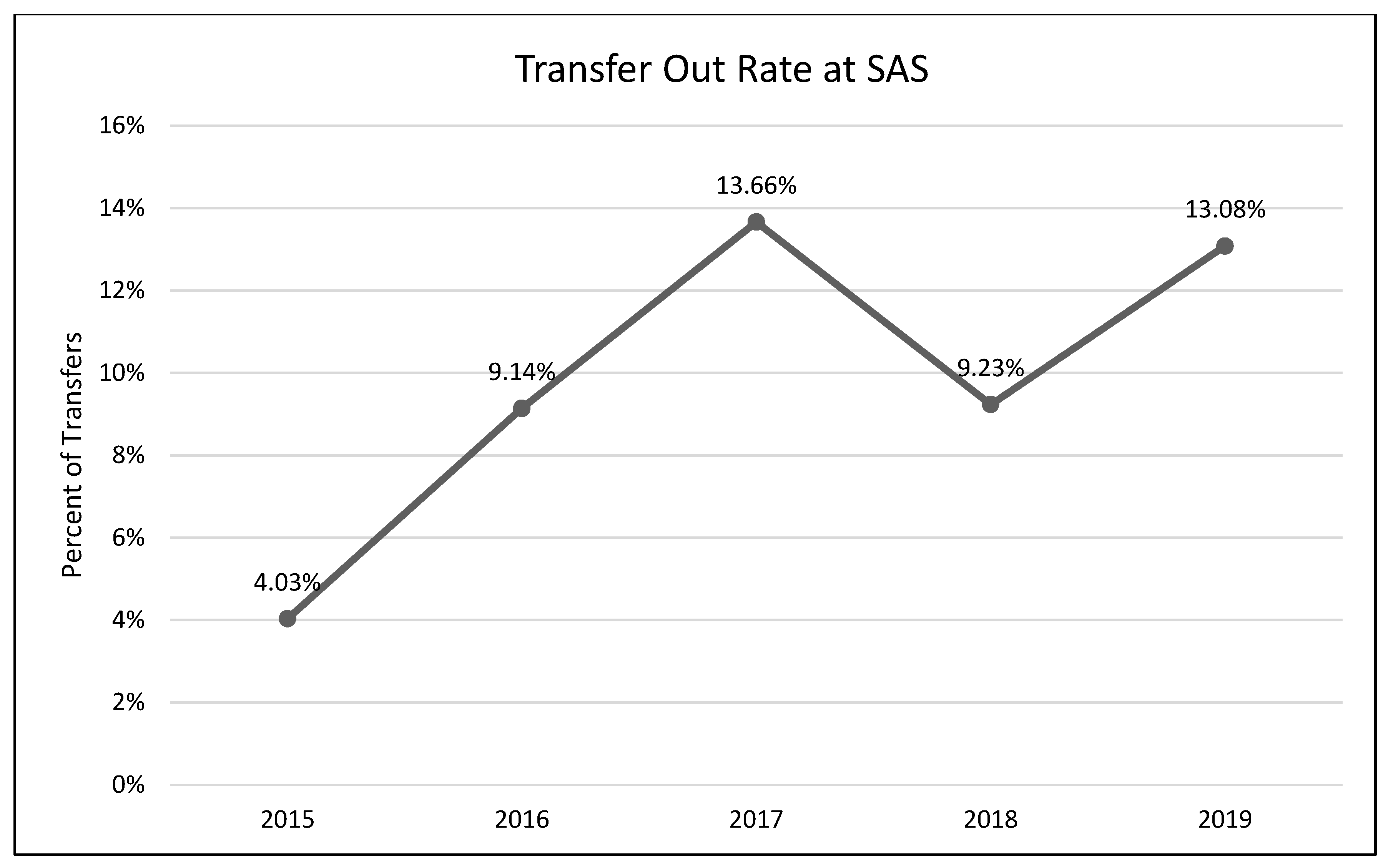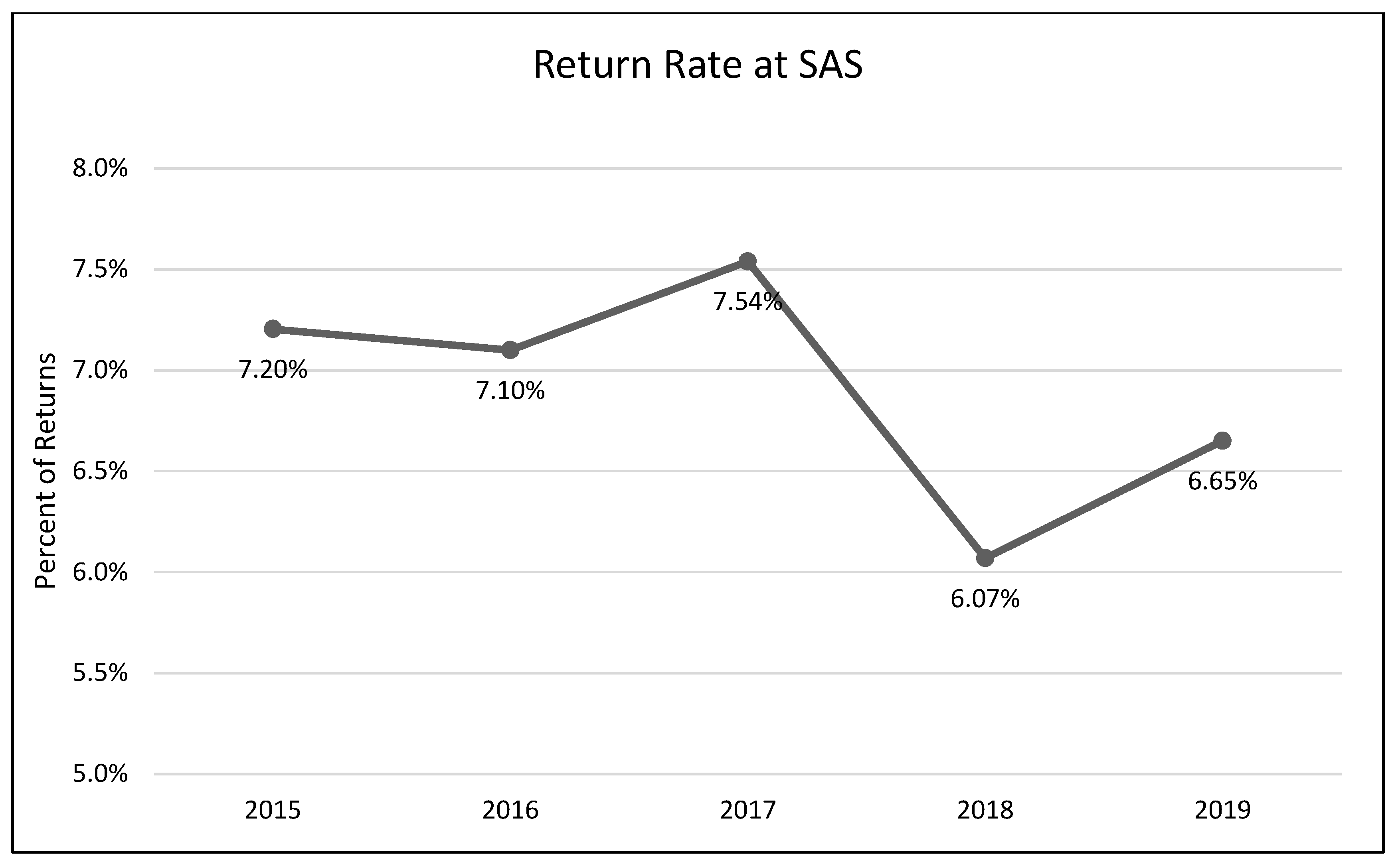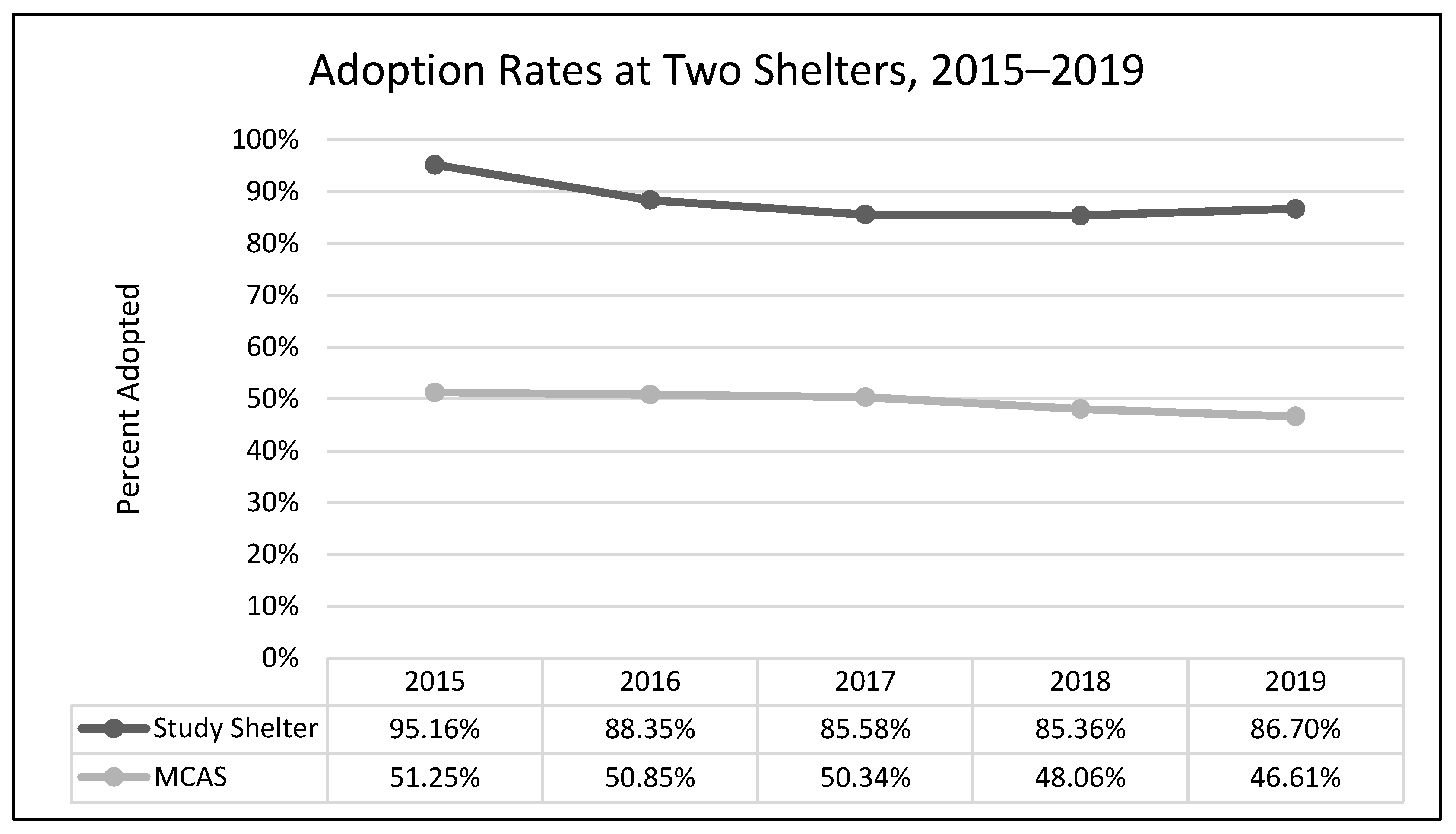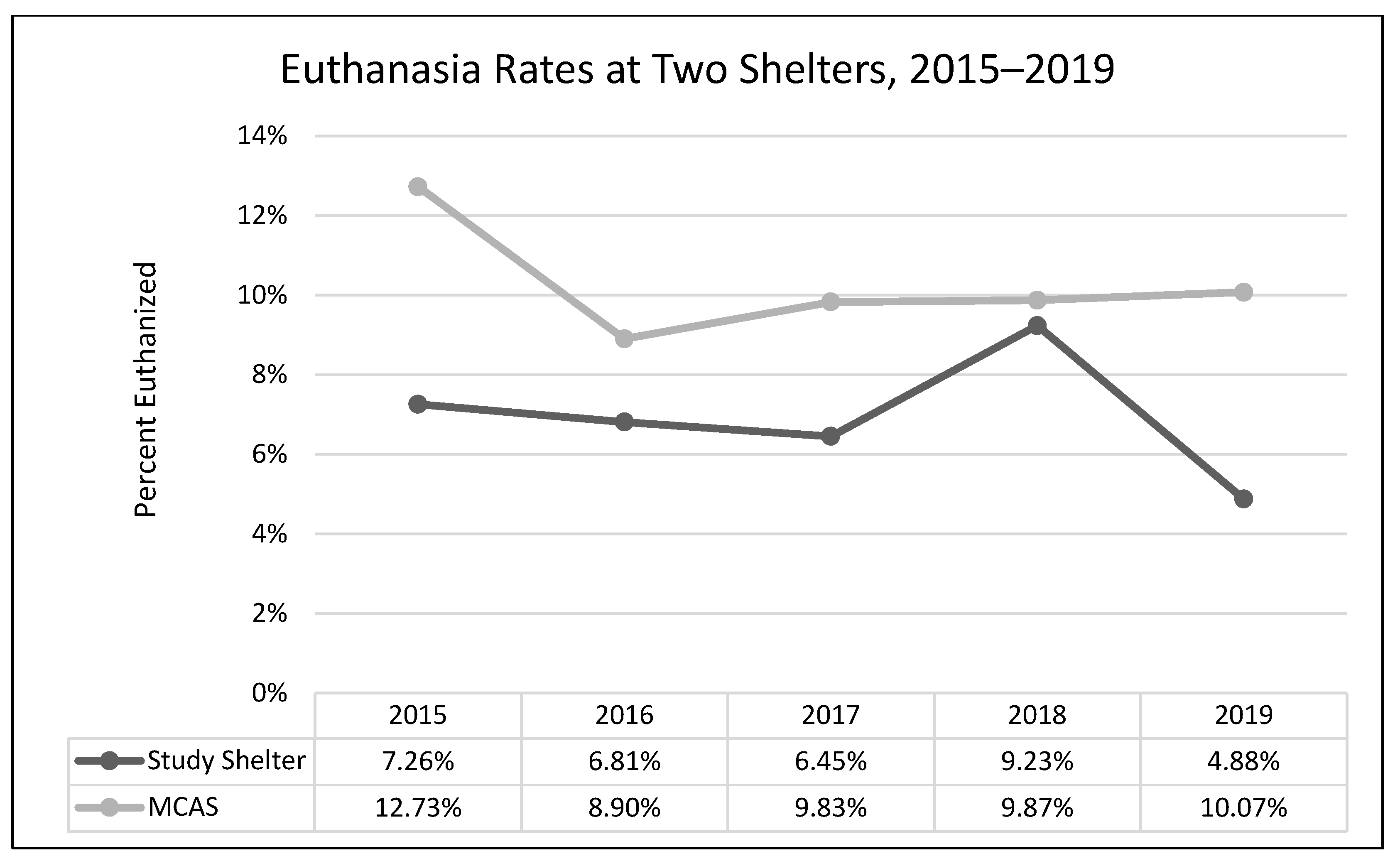1. Introduction
Program evaluation is an important component of applied animal behavior science that is seldom found in the published literature [
1]. Despite the popularity of evidence-based practice in virtually all arenas of organizational life, program evaluation is less common than it should be. For example, a 2017 government-wide report from the Government Accountability Office describes the implementation of program evaluation in only approximately 40% of governmental programs in the United States [
2]. Information about the rate of program evaluation in private or not-for-profit entities is difficult to estimate, and even program evaluations in the public domain are not widely disseminated in scientific literature. In applied animal behavior science—where the main goals are to improve the care, management, and welfare of animals—there is a dearth of available data on the evaluation of programs instituted by the largest animal welfare organizations.
Many large and influential animal welfare organizations, including the American Society for the Prevention of Cruelty to Animals (ASPCA), have their own applied animal behavior research teams that not only conduct and publish applied research on domestic animals, but also use the results of their work to inform their own policies and practices. Specifically, as applied to the area of animal sheltering, one such program is the ASPCA’s Meet Your Match
® (MYM
®). Originally designed to pair potential adopters with available pet dogs, the program was extended to include pet cats in 2007 and modified into its current form in 2015 [
2,
3]. The research conducted in designing the feline side of the program was not published in a peer-reviewed journal; a brief summary of that research can be found in the ASPCA’s MYM
® Feline-ality™ training manual [
3]. A modification of the original Feline-ality™ program was undertaken in 2015 in response to logistical concerns from participating shelters (e.g., 72 h hold before assessment could be performed) and a comparison of the modified program and the original program was published [
4]. No further work evaluating the implementation of (process evaluation) or effects of (outcome evaluation) the MYM
® Feline-ality™ program has been published subsequent to its adoption by at least 100 animal shelters [
5]. The purpose of our study is to evaluate MYM
® Feline-ality™.
In ASPCA’s initial testing during program design phases, as well as in the subsequent modification study, the period following the implementation of the MYM
® Feline-ality™ program was characterized by an increase in cat adoption rates, decreased euthanasia rates, decreased return rates, and shortened length of stay in the shelter for cats [
3,
4]. Yet, not all of these improved outcomes were attributable to owners adopting cats that matched the indicated Feline-ality™, as 45% of pairings examined were not exact matches [
3]. In a follow-up survey to the ASPCA 2007 beta testing, respondents indicated that the cats they had adopted largely behaved as they expected them to, based on the information they had obtained during the MYM
® process [
3]. The ASPCA data were in alignment with previous research: accurate expectations for a new pet have been demonstrated as contributive to adoption success [
3,
4,
6,
7,
8,
9,
10,
11].
For both adopters and shelter staff alike, overall satisfaction with the MYM
® Feline-ality™ program was described as high during the ASPCA’s original beta testing [
3]. Five shelters participated in the beta testing—the Animal Refuge League of Greater Portland; the Wisconsin Human Society in Milwaukee; the Hamilton-Burlington SPCA in Ontario, Canada; the Kansas Humane Society of Wichita; and the Humane Society of Boulder [
3]. All five shelters were private, not-for-profit organizations; two were open-admission shelters while three were closed-admission (open-admission means that owners can surrender their animal at any time and for any reason; closed-admission means that the shelter limits which animals they are willing to accept). ASPCA pilot testing was completed in multiple phases using boarding facilities and shelters [
3]. Two of the shelters used in the pilot testing were also used in beta testing (the Animal Refuge League of Greater Portland and the Hamilton-Burlington SPCA). The Humane Society of Boulder, one of the shelters used in the pilot testing, was also used in the 2015 modification study (open-admission) [
3,
4]. Data regarding satisfaction following the implementation of MYM
® Feline-ality™ in shelters outside of the 2007 ASPCA pilot and beta testing are not available in the scientific literature, nor is any further evidence that the program is associated with the favorable changes in adoption, euthanasia, returns, and length of stay reported. Information about the results of the adoption of this program in the wider animal sheltering system would help applied animal behaviorists make evidence-based decisions about the allocation of the scarce resources available in animal care, management, and welfare.
In order to evaluate the MYM
® Feline-ality™ program, and in collaboration with the Seattle Animal Shelter (SAS), we considered three aspects of program evaluations: needs assessment, outcome evaluation, and process evaluation. Needs assessment involves identifying gaps in current practices that might interfere with desired outcomes and providing suggestions of ways to ameliorate obstacles. The needs assessment relevant to, but independent of, this present study identified multiple areas needing improvement, including standardizing the assessment of cats, for which it was recommended to use the MYM
® Feline-ality™ program [
12]. The needs assessment is discussed and an outcome evaluation (analysis of the effectiveness of a program) and a process evaluation (analysis of implementation) are examined herein.
To the best of our knowledge, the present study represents both the first outcome evaluation and the first process evaluation of the MYM® Feline-ality™ program since its introduction into sheltering practice. Using data from a five-year period (2015–2019) and based on findings described in the available literature on the program, we expected to see a favorable change in adoption, euthanasia, return, and length of stay for cats at SAS following implementation of the program. As part of a retrospective process evaluation, we also examined errors made during the implementation of the program.
4. Discussion
The outcome evaluation presented herein, when viewed in tandem with the process evaluation that revealed an extremely high error rate, provided no evidence of any effect of the MYM® Feline-ality™ program at our study shelter.
The MYM® program at Seattle Animal Shelter (SAS) was begun in early 2017 and continued through the end of that year. Outcomes were examined for 2 years prior to Feline-ality™, the year of its implementation, and two years subsequent (2015–2019). Length of stay was predicted to decrease after Feline-ality™ began (2017); length of stay did not significantly change across years. The return rate was also predicted to decrease; the return rate did not change significantly across years. Adoption was expected to increase in 2017, and euthanasia and returns were expected to decrease in 2017; we had no prediction regarding the transfer rate as Feline-ality™ makes no claims regarding an effect on transfers. We also had no specific predictions for 2018 or 2019. The distribution of outcomes (frequency of adoption, euthanasia, and transfer to other facilities) varied significantly across the across the five-year study period at SAS. However, it is important to note that the chi-square test is a global test and does not identify which specific outcome drove the overall significance. The significant chi-square result might have been driven by any of the changes we see in the visual representation of the data. However, this is a descriptive interpretation and does not imply inferential or generalizable results. The overall adoption rate at SAS fell across the 5 years, as did euthanasia rates. The changes in adoption rate and euthanasia rate in 2017 were negligible (and running counter to our prediction), followed by an increase in euthanasia in 2018. The transfer rates out of SAS increased overall and the changes year-over-year in transfer rates appear to have contributed the most to the overall significant chi-square. The euthanasia rate initially was trending downward across 2015 through 2017, spiked upward in 2018, and appeared to be decreasing again in 2019. The SAS euthanasia rate pattern seems to be the opposite of the transfer out rate pattern: as more cats are transferred to other facilities, the need for euthanasia may decrease (and vice versa). This inverse correlation between euthanasia and transfer is sufficient to explain the overall significant differences seen in our data. If there was any effect of MYM® in 2017, this effect does not appear to have persisted beyond that year, not unsurprisingly given the extremely small effect size describing the differences in outcome variables between years. These small and short-lived effects seem to indicate either that the MYM® Feline-ality™ program is an ineffective program and/or that it was poorly implemented.
Overall, transfer rates increased in both shelters (SAS and MCAS), and adoption and euthanasia rates decreased (no data for return rates or length of stay were available from the comparison shelter). The apparent spike at our study shelter (SAS) in euthanasia in 2018, mirrored by the 2018 dip in transfer rates, is the only deviation from the similarity in overall patterns between the two shelters. However, when compared with publicly available data on overall trends in SAS transfers and “other than live releases” (which include euthanasia and other deaths) for our study shelter (2016–2019), this same mirrored spike occurred shelter-wide (including all species handled by SAS) and is thus not limited to cats, nor attributable to Feline-ality™ [
21]. Furthermore, the similarity in trends across years for the two shelters fails to rule out the possibility that history or maturation effects occurred at SAS; it is possible and even likely that the trends in both shelters were due to some alternative explanation(s), the most likely of which might be overall changes in shelter practices and attitudes over that time period. Since the Asilomar Accords of 2004, during which a group of 20 animal sheltering stakeholders (including the ASPCA) called for a national database to track sheltered animals and their outcomes [
21], there has been a concerted effort and some success in the animal sheltering community at large to increase the live release rate and decrease euthanasia, often by transferring animals taken in by large or municipal shelters to other animal rescue organizations [
22]. This explanation explains our data better than MYM
® Feline-ality™. See
Figure S5 for a thorough exploration of systematic alternative explanations addressed by our study design.
Program evaluation is composed of multiple components, the first of which is a needs assessment. In the needs assessment commissioned by the shelter, SAS was advised regarding multiple areas that could be changed in order to improve overall adoption success and well-being. For cats specifically, aside from the MYM® Feline-ality™ program, it was also suggested that the shelter should improve training of volunteers and staff in basic feline maintenance and behavior, provide enrichment to cats (e.g., olfactory stimulation, food puzzles, and auditory enrichment), and change and codify cage housing procedures for cats (e.g., provide hiding areas, limit exposure to dogs, place outgoing cats in more exposed cages, while reserving quiet cages for new or scared cats). Given our quasi-experimental design, it is important to consider what effect, if any, the needs assessment might have had on our results.
In terms of the needs assessment, any effect caused by its existence and dissemination, or changes made as a result of its suggestions (outside of the MYM®), would fall under the category of historical, or external, threats to inferring causality. Simply being exposed to the needs assessment, prior to any further intervention, could induce behavioral changes in shelter staff that might improve outcomes for cats, as staff attempt to ameliorate problems that they have now become aware of (e.g., seemingly aggressive cats transferred out rather than euthanized), or might alter the outcome data in other ways, such as lowering the average length of stay, as more cats are transferred out. The needs assessment was conducted in early 2016 and shared with the shelter in May of 2016; transfer rates did indeed begin to increase in 2016 and continued to do so in 2017. However, if there was an effect of the needs assessment that drove transfer rates initially, that effect disappeared by 2018 and thus cannot explain the rebound in 2019. Given that transfer was not specifically mentioned as a suggestion in the needs assessment, we consider any effect of the assessment on transfer rates to have been unlikely to induce any lasting change in cat outcomes.
Specific suggestions made in the assessment might also pose history threats to the internal validity of our outcome evaluation. Improving training for staff and volunteers regarding cats overall is one such possibility. As staff became more aware of species-specific considerations and behavioral indicators related to which would benefit from a foster home, which might benefit from transfer to another facility, and which were likely to do well in a shelter environment, it is logical to assume that outcomes could be influenced. However, outside of the intensive Feline-ality™ training provided by S.D., there is little evidence that other training and education was undertaken at an appreciable scale. The SAS progress report summarizing the behavior program in May 2018 indicated that written volunteer materials were updated, and that four volunteers and two staff members (comprising the Cat Behavior Team) met with another area shelter with a well-established cat behavior program and received training in learning theory [
23]. The Cat Behavior Team focused largely on cat behavior modification but, per the progress report, the need for such behavioral interventions decreased after changes in housing and enrichment, and the Cat Behavior Team was not expanded [
23]. It is unknown how much of an effect this additional training might have had, but given the small number of people involved, it is reasonable to assume that it is unlikely to explain our results. Based on personal observation, many of the other recommendations regarding enrichment, housing, and exposure to dogs were either not instituted or instituted haphazardly or inconsistently, and therefore were unlikely to have influenced our results in a systematic fashion.
Another alternative explanation, suggested by a staff member in an internal program evaluation submitted to management at the end of 2017, attributed falling euthanasia rates in 2017 to a hospice care program (“Fospice”), instituted in 2016, in which cats with a diagnosed illness and a prognosis of less than six months were placed in long-term palliative foster care, rather than euthanized [
24]. However, while Fospice does indeed delay euthanasia, it does not prevent it, and this delay in euthanasia does not do a better job of explaining the subsequent pattern we saw in euthanasia rates in 2018 (spike) and 2019 (drop), than does the change in transfer rates. It is more likely that the Fospice program would have affected the average length of stay for cats, as animals that would have previously been euthanized owing to terminal illness instead lived longer in foster care. However, LOS did not change significantly over the study period.
The same 2017 internal staff evaluation also suggested that there might have been an effect on cat outcomes related to the hiring of full-time veterinary staff and/or the creation of a cat adoption follow-up team [
24]. However, it reasonably follows that an increase in diagnosis and in-shelter treatment of manageable medical conditions would have increased the pool of cats that would now be deemed adoptable, and that the diagnosis of unmanageable and terminal illnesses would either increase the euthanasia rate or increase the number of cats eligible for Fospice (which, if happening at a high rate, should have showed up in our LOS data), none of which explain the changes in adoption rates or euthanasia rates in our data, either in 2017 or in years following. Return rates did not change significantly, providing no evidence that the cat adoption follow-up team was a significant factor in our findings.
Whereas the lack of substantive effect may indicate that MYM
® Feline-ality™ does not perform as purported, it is equally as likely (if not more so) that this absence of evidence of any results reasonably attributable to Feline-ality™ has occurred because the error rate in implementation of the program was very high. The retrospective process evaluation revealed that only three cats were matched with their adopters along both Feline-ality™ dimensions without any errors in either the assay or the survey. Nine cats were matched correctly along both dimensions despite errors in the underlying paperwork. In the original work creating the MYM
® Feline-ality™ program, the ASPCA describes that approximately 45% of cats were matched perfectly to their new owners, as compared with 4.9% at our primary study shelter [
3]. Furthermore, the majority of cats were paired without any record of the adoptive owner having completed a CAS. Of those that did complete the CAS, the error rate was 85%. The Feline-ality™ behavioral assay also showed errors. However, the assay could more flexibly absorb errors owing to the range of numbers allowable by the scales; errors caused a cat to be incorrectly labeled as the wrong Feline-ality™ in only 4.4% of the cases. The fact that a poorly implemented program necessarily impacts the results of an outcome evaluation underscores the need for process evaluation concurrent with implementation.
The lack of effect may have occurred because the error rate in implementation of the program was very high. It is also possible that the program is fundamentally flawed in some other way that renders improvements in implementation moot; see [
25] for an exploration of the underlying personality trait measurement that forms that basis of Feline-ality™. It is also possible that our study shelter may have differed in other ways that could have directly contributed to the poor implementation of the MYM
® Feline-ality™ program. Specifically, the study shelter suffered from inadequate staffing levels and an inefficient distribution of labor [
12]. It may also have occurred because SAS stopped implementing the MYM
® program as it was designed. In early 2018, the shelter reported that it had modified the program such that most cats were “fast-tracked” and only a subset of less well-socialized cats were given the entire Feline-ality™ assessment. Fast-tracking was described as follows in an internal staff report.
“Once the cat has eaten on its own, been in the shelter a minimum of 18 h, and is medically sound enough to go through a Feline-ality™ assessment, the assessment can start. The Assessment will start as any normal Feline-ality™ would, however if the cat has an aggregate score of 5 or higher on items #1 through #4, the cat will be fast tracked. If the aggregate score is below a 5, the remainder of the Feline-ality™ will be performed and the cat routed accordingly… Likely we would only be performing a completed Feline-ality™ on what would be deemed purple cats (Private Investigator/Secret Admirer/Love bug), which are also the harder adoption cases aside from cats that are medically fragile or have more profound behavior concerns (forwardly aggressive). We would still keep the application process the same and there would be no changes done to the “cat adoption survey” at this time” [
24].
Fast-tracking may have started earlier than management was made aware of. There also may have been attrition in completion rates (another threat to internal validity). Either could account for the fact that only 183 cats were recorded as having undergone the Feline-ality™ testing in 2017, despite the fact that 527 cats that theoretically could have been assessed were taken in during 2017. Fast-tracking could also explain why our distribution of Feline-alities™ is 42.5% “purple” or lower valiance cats, and only 5.5% are “green” or high valiance cats (it is impossible to assess whether our distribution is statistically significantly different from previous distributions, as the distributions of Feline-alities™ in the ASPCA training manual and Weiss et al. were not described in detail [
3,
4].
SAS suspended Feline-ality™ assessments between January 2018 and April 2018 in order to evaluate whether length of stay (LOS) would be affected. According to their internal analysis, average LOS was not affected by the suspension of the assessment and remained stable, though variability appeared to decrease [
23]. The shelter interpreted the results of their evaluation to indicate that the MYM
® program was not delivering the desired outcomes, but that perhaps simply training staff to better recognize body language and understand feline behavior was improving overall cat adoption decisions [
23]. It was their final conclusion that they should therefore “continue to train Animal Care staff on a formal program to recognize cat body language and behavior that leads to good routing decisions” [
23]. However, the technique used to evaluate the change in LOS and the change in variability in LOS was not statistically rigorous. Our post-hoc analysis established homogeneity of variance before and after the implementation of the MYM
® Feline-ality™ program, rather than the decreased variability suggested in the report (S4). The extreme decrease in LOS in February of 2017 is likely attributable to the statistical phenomena of regression to the mean, and does not represent an effect of Feline-ality™, nor can the variability be interpreted as evidence of an effect of general cat behavioral training, as was suggested in the SAS report [
23].
At this point, it is unclear whether any form of the MYM® program remained in place after January of 2018, nor is it clear what, if any, formal cat behavior training continued after this date. All of these things combined with poor implementation of the program may explain the falling adoption rates, rising return rates, and increasing lengths of stay that appeared to be recurring by the end of the study period. It is, however, both impossible to attribute any changes to MYM® Feline-ality™ and equally as impossible to rule out any effect; without proper implementation, an outcome evaluation is uninterpretable.
Our work has revealed some weaknesses inherent in the MYM® Feline-ality™ program that contribute to difficulties in implementation. First and foremost, the fact that the CAS allows for no human error is simply not practicable. Any of the first ten questions not answered or answered incorrectly, and not caught and corrected by the staff, can and did lead to errors that prevented accurate matching between prospective adopters and appropriate cats. A difference in just one point in scoring the CAS can lead to assignment of the incorrect Feline-ality™ match, which shows that the behavioral assay is more robust to human error because of the larger range of values that describe the Feline-alities™; small math errors are less likely to have an effect. It is not reasonable to assume that staff will catch all errors on the CAS and some error rate in the overall program is to be expected. However, the high error rate seen here may, at least in part, indicate that the training materials provided by the ASPCA are inadequate.
The materials available for training in the MYM
® Feline-ality™ program are lacking in some key areas. There is one video for practicing the entire behavioral assay and one portion of a video that walks through the scoring of the CAS. Because we had access to the DVD from the original program, we were able to piece together an additional video of the full assay for use as practice in the training sessions, as well as two additional CAS practice videos. As part of their training, staff also practiced the full assessment on live cats during training, with S.D. there to provide feedback, as well as practiced scoring new CASs provided by S.D., with oversight from S.D. Furthermore, the CASs provided by the ASPCA for scoring practice did not include any errors, so learners would not have the opportunity to practice catching errors; in our training, this was provided. Additionally, the ASCPA materials do not provide any other opportunities for self-evaluation, such as quizzes; we created quizzes and incorporated them into both staff and volunteer training. All of this means that our study shelter actually had more extensive training on the assay and the CAS than they would if they had only used the ASCPA materials, though by necessity, on an ad hoc basis. There is no information that describes how other shelters might use or improve upon the materials provided by the ASPCA; there is likely to be variability in this aspect of the program implementation, which points to weaknesses in elements that are necessary prior to the successful adoption of a new program, namely diffusion, and specifically dissemination and replication (for a useful definition of these terms, see Goldman [
26]).
Another potential area of weakness is in the training surrounding adoption counseling. As far as we are aware, there are no data regarding the efficacy of this aspect of the online training (communicating the results of the Feline-ality™ assay and the CAS effectively to potential adopters). The focus of this part of the training material is on presenting the information to adopters using specific soft skills (such as keeping one’s tone positive or ascending, using open-ended questions, paraphrasing to indicate listening, and so on). Soft skills are notoriously difficult to train and even more so via non-interactive online media [
27,
28]. During training at our study shelter, we did roleplay adoption counseling and it is possible that other shelters might do this, too. Based solely on the materials from the ASCPA, however, it is unlikely that adoption counseling techniques would be affected, which could also adversely affect the implementation of the MYM
® Feline-ality™ program.

